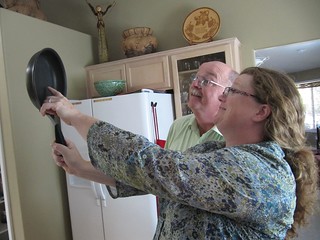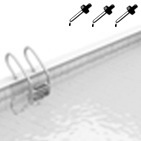OREGON CITY, Ore. — Dave Sohm’s house is immaculate. Every tool in the garage has its own hook. The kitchen countertops gleam.
But in his house –- as with most houses –- toxic chemicals are hiding in plain sight.
Sohm wants to know where. 
“I’m curious about what things there are,” he says. “I don’t know what impacts I may be having that I’m not even aware of.”
Jen Coleman, an outreach director for the Oregon Environmental Council is at Sohm’s house to help. Armed with a list of chemicals that have toxic effects on people and the environment, Coleman digs through cabinets, checks ingredient lists and compares them with contaminants that have been found in local waterways.
First on her list is a chemical called triclosan. It’s found in antibacterial soaps, toothpaste and deodorant. And it can be toxic to fish.
“I think the best place to start is probably the bathroom,” she says. “What I’m looking for first is the ingredients you put on your skin or your hair and that you rinse off on the bathroom and then rinse off in the shower.”
The water that goes down the drains and toilets in Sohm’s house is funneled into a wastewater treatment plant. The plant removes pollutants and sends treated water into the Willamette River.
But scientists are increasingly finding evidence that everyday chemicals, pharmaceuticals and human hormones pass right through the treatment plants and into waterways across the country.
U.S. Geological Survey hydrologist Jennifer Morace tested the water coming out of nine wastewater treatment plants in the Northwest. She found traces of dozens of chemicals, from household products like sunscreen, fragrances in lotions or shampoos, antibacterial agents from hand soaps, and pharmaceutical chemicals.
One Portland treatment plant was sending the equivalent of 400 Benadryl pills into the Columbia River every day.
“What goes down your drain really does go somewhere,” she said. “A lot of people may think, ‘oh, it goes to a treatment plant so it’s taken care of.’ But there’s only so much we can take care of.”
Treatment plants don’t remove these chemicals partly because it would be really expensive. But also because they don’t have to.
These new pollutants aren’t regulated under the Clean Water Act, though some of them have toxic properties that threaten both human health and fish and wildlife. So far they’re only being detected at very low levels, Morace said. But no one knows what happens when they’re all mixed together.
“A lot of these compounds are designed to be bioactive. Pharmaceuticals are designed to have a biological effect in your body,” she said. “That’s why you take them. So it’s not hard to imagine that when they’re excreted from your body and make their way into the ecosystem that they might still have that biological effect on the fish that live in the ecosystem. The bugs. The birds that eat the fish.”
As for what is regulated, there are 126 toxic chemicals on the Clean Water Act priority pollutant list. But not a single pollutant has been added to that list since 1977.
So there are no legal limits for most of the household chemicals that are showing up in the water today. Most of them haven’t been studied enough to know how much is too much to put in a waterway.
During Coleman’s walk-through of Sohm’s house she didn’t find any triclosan. But she did find lots of shampoos and soaps with fragrances in them. The fragrances likely contain phthalates that interfere with hormones in the body.
When they moved into the kitchen, Coleman found a likely source of perfluorinated compounds that are toxic to wildlife. They’re also known as Teflons, and they can be found in non-stick cookware.
“So then my pan that I always cook breakfast in?” Sohm asked.
Yes, Coleman said. The pan he cooks breakfast in does have a nonstick coating that could contain Teflon chemicals. Those chemicals are released when the pan gets scratched or overheats.
“If you hold it up to the light, you can see it’s in pretty good shape – there aren’t too many scratches,” she said. “The thing about overheating a pan is it’s so easy to do, and at that point it’s probably time to start looking for a new one.”
Household chemicals that aren’t removed at the wastewater treatment plant can actually show up in drinking water downstream. A study of 48 drinking water sources in Oregon found a long list of contaminants including bug spray, cholesterol, hormones and herbicides –- again at very low levels.
Sheree Stewart, drinking water protection specialist for the Oregon Department of Environmental Quality, said the tests found evidence of human waste everywhere they looked, and some of it is not removed in either the wastewater or drinking water treatment processes.
“If you have a drinking water intake downstream of a wastewater treatment plant, which we do have over 60 in the state of Oregon, we do tend to find these very low levels of contaminants in drinking water,” she said. “Even the absolute best wastewater treatment will certainly have very, very low levels of a lot of these compounds in the wastewater discharge. They meet all the standards and the plants are operating at the best they can, but there are still low levels of these contaminants that are leaving those facilities.”
How low were these very low levels? Most are being detected in parts per trillion. That’s the equivalent of one drop in 20 Olympic-size swimming pools.
At that level, experts say it’s really hard to determine the toxic threats to humans or the environment. And it may be easier to eliminate the source of the pollution than to develop a regulation to deal with it under the Clean Water Act.
Mary Lou Soscia, the Columbia River coordinator for the Environmental Protection Agency, said it would take an act of Congress to add these new pollutants to the list of what’s regulated under the Clean Water Act. Instead, her agency is working with industry and consumers to reduce and replace toxic chemicals in everyday products.
When the act passed 40 years ago, “there were rivers on fire and it was focused on cleaning up rivers,” she said. “We’ve evolved to the point where we recognize the most important thing is cleaning up pollution at its source.”
Robert Adler, an environmental law professor at the University of Utah, said the EPA is actually required to regulate all pollutants under the Clean Water Act – even the ones that aren’t on the priority pollutant list. But the agency has been slow to act on that part of the law.
“The statute was very ambitious, very aspirational and sought to completely eliminate pollutant discharges, which has proven to be very difficult,” he said. “We got a lot of the nastiest pollutants out of the nastiest dischargers, and it’s just a lot harder to make progress after you’ve eaten that low lying fruit, as it were.”
Adler agrees that keeping toxics out of products in the first place is a viable solution too.
Back at his Oregon City home, Sohm asked about the cleaners he uses.
“We have a moss issue on the roof,” he said. “And I don’t know what’s the right way to deal with that because there are a lot of things like this recommended. Let’s spray bleach on it, and then it goes through the storm sewer through the gutter.”
The home tour revealed the hiding places for flame retardants in electronics and furniture, and pesticides in the wasp and hornet killer in his garden shed.
And in the end Sohm agreed to try brushing the moss off his roof with a broom instead of spraying a chemical to remove it.






